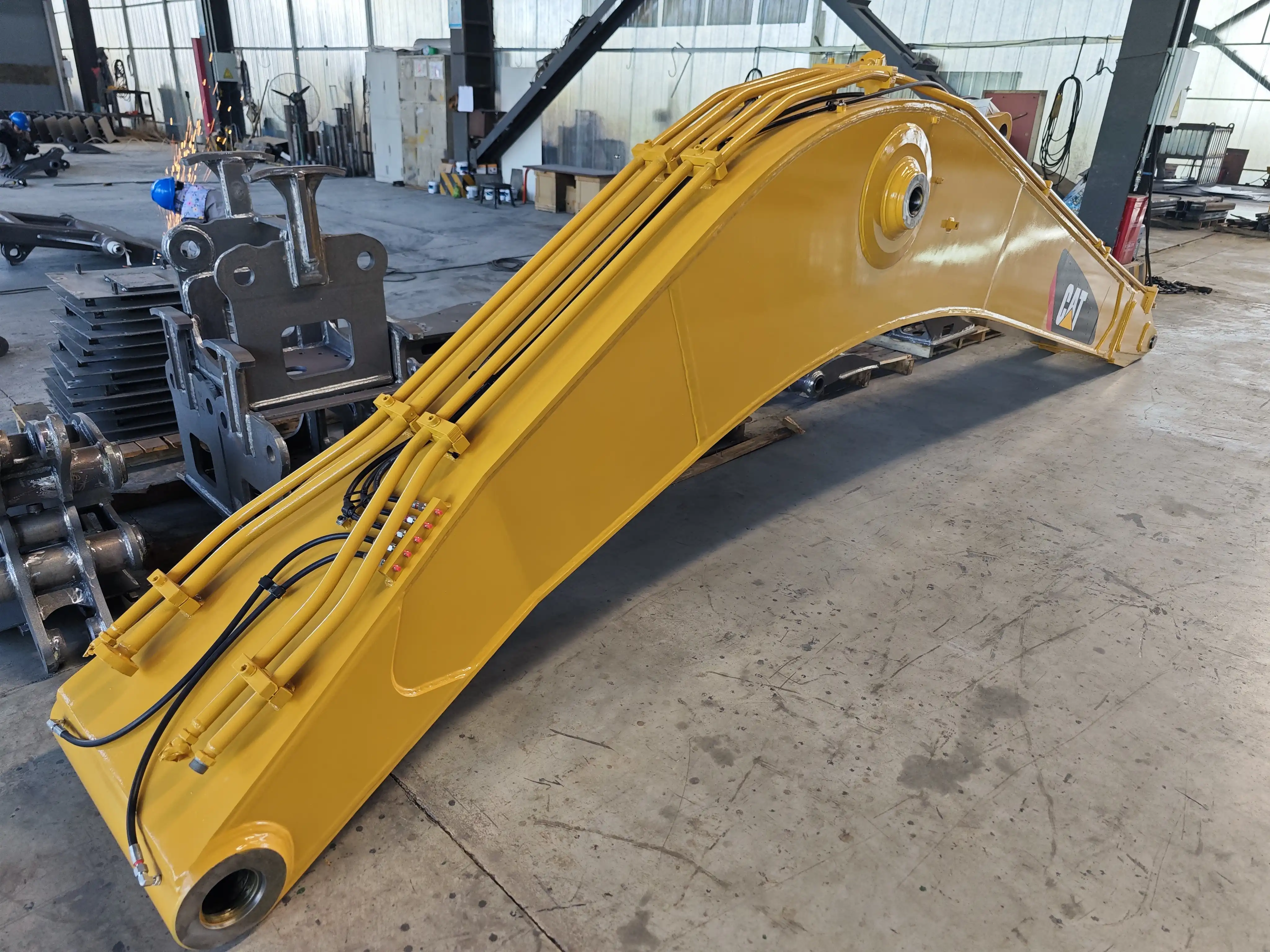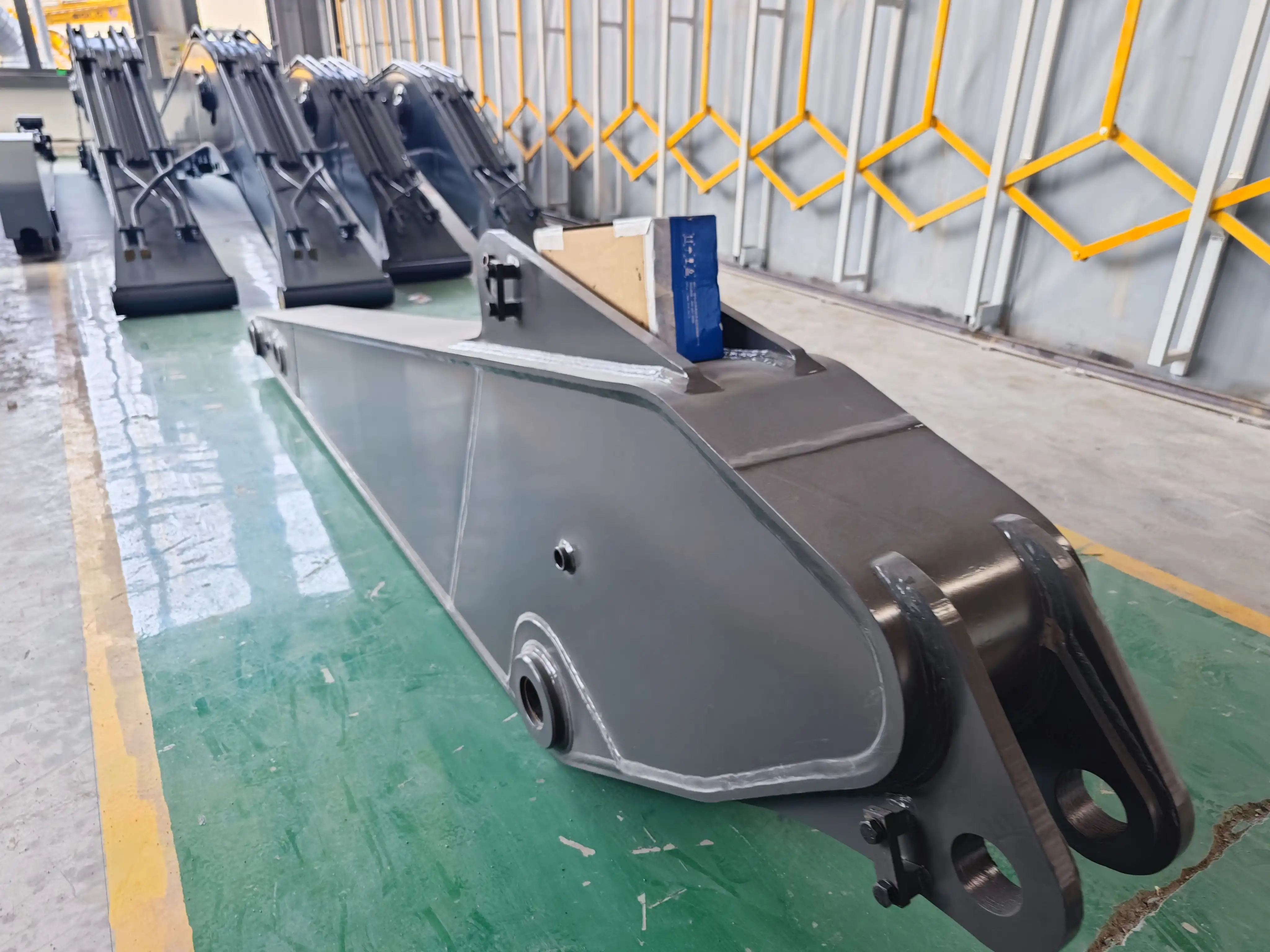What are the different excavator booms?
The excavator's boom and arm assembly forms the functional extension that enables digging, lifting, and material handling across various applications. In the construction machinery industry, understanding the different types of standard size excavator boom and arm configurations is essential for selecting equipment that matches specific project requirements. From railway construction to mining operations, the right boom type significantly impacts efficiency, productivity, and safety on the worksite. Modern excavators feature several boom designs, each engineered for particular applications and operational environments. These specialized configurations allow operators to tackle diverse challenges, from standard digging operations to specialized tasks like demolition or long-reach excavation in places with access limitations.
Standard Boom

The standard boom, also known as the mono boom, represents the most common and versatile standard size excavator arm configuration found across construction sites worldwide. This single-piece design provides an optimal balance of digging depth, lifting capacity, and operational flexibility.
Design and Configuration
The defining feature of the standard boom is its monolithic construction—a single, unbroken beam crafted from high-tensile steel alloys (e.g., quenched and tempered grades like ASTM A514 or S690QL) to withstand cyclic loading and impact forces. This robust framework is paired with articulating arms of variable lengths, allowing operators to tailor the machine’s reach and depth to specific tasks. Visually, the mono boom forms an inverted "V" when viewed in profile, a geometry that distributes mechanical stress efficiently: the boom’s upper section resists compressive forces during lifting, while the lower portion handles tensile stresses during digging.
Manufacturers employ advanced computational tools, such as finite element analysis (FEA), to refine the boom’s dimensional ratios—specifically the length-to-thickness ratio of the boom tube and the angular positioning of pivot points. For example, a typical medium-sized excavator (25 tons) might feature a boom with a 5.5m main tube, paired with a 3m arm, creating a working triangle that maximizes breakout force (the force required to break soil from its bed, often 20–30 kN for mid-sized machines) while minimizing stress concentrations at critical joints. These joints, equipped with greased spherical bearings or bushings, allow smooth articulation with the excavator’s main frame and the arm, supported by hydraulic cylinders designed to deliver consistent torque across the boom’s arc of motion (typically 140–160 degrees of vertical movement).
Applications and Benefits
The standard boom’s versatility shines in general construction tasks, where adaptability to changing site conditions is critical. In trenching for utilities (e.g., laying pipes or cables), its balanced reach (up to 12m horizontal reach for a 30-ton excavator) and precise control allow operators to dig uniform trenches 4–8m deep while avoiding over-excavation. For foundation excavation, the boom’s stable lifting capacity (e.g., a 20-ton machine can lift 5 tons at a 5m radius) ensures efficient removal of spoil and placement of materials like gravel or concrete.
In loading operations, such as transferring excavated soil to dump trucks, the boom’s quick cycle times—enabled by optimized hydraulic flow rates and lightweight arm designs—boost productivity by reducing idle time. Construction firms also value its reliability in road construction, where it excels in grading embankments, clearing debris, and excavating drainage ditches. The design’s inherent stability, thanks to its low center of gravity and counterweighted balance, minimizes machine sway during lateral movements, a critical safety feature on sloped terrain or near sensitive structures.
Size Variations
Standard booms are available across the entire spectrum of excavator sizes, from mini excavators (1-6 tons) to heavy-duty machines (50+ tons). For mini and compact excavators, standard booms typically range from 1.5-3 meters in length, while medium-sized machines (20-30 tons) utilize booms measuring 5-6 meters. Heavy-duty excavators employed in mining and large-scale construction feature standard booms extending 7-9 meters, providing impressive digging depths while maintaining structural integrity under substantial loads.
Long Reach Boom

Long reach booms represent specialized configurations designed to extend the excavator's operational range significantly beyond standard capabilities, enabling work in hard-to-reach areas or across obstacles.
Extended Capabilities
Long reach booms feature extended lengths that dramatically increase the excavator's working radius, often doubling or tripling the reach of standard configurations. These specialized assemblies typically incorporate reinforced pivot points and hydraulic systems to manage the increased leverage forces. The design emphasizes reach over lifting capacity, creating a distinct operational profile suited for specific applications where access presents significant challenges.
Applications and Work Environments
Long reach excavators excel in dredging operations, riverbank restoration, and pond cleaning where operators must reach across water bodies without entering them. They prove invaluable in slope stabilization projects, allowing machines to remain on stable ground while working on steep inclines. In railway maintenance, long reach booms enable vegetation management and drainage work from a position of safety alongside tracks. Environmental remediation projects often utilize these extended configurations for contaminated site cleanup where maintaining distance from hazardous materials is essential.
Design Considerations
Long reach booms require careful engineering to counterbalance their extended profile, often incorporating heavier counterweights than standard models. The hydraulic systems undergo modifications to handle the altered pressure requirements resulting from the changed leverage dynamics. Operators must undergo specialized training to manage the unique handling characteristics of long reach equipment, particularly regarding stability awareness during operation. Modern designs feature advanced sensor systems that monitor boom position and load distribution to prevent overextension and potential tipping hazards.
High-Reach Demolition Boom

High-reach demolition booms represent highly specialized excavator attachments designed specifically for the controlled dismantling of multi-story structures and industrial facilities.
Specialized Structure
High-reach demolition booms feature modular, multi-section designs that can extend vertically to heights ranging from 15 to over 60 meters depending on the base machine size. These specialized assemblies typically incorporate hydraulic articulation points that enable precise positioning of demolition attachments at extreme heights. Safety features include hydraulic quick-disconnect systems allowing rapid boom configuration changes and emergency lowering capabilities. The structural engineering emphasizes both vertical reach and the ability to support heavy demolition attachments like crushers, shears, and hammers at extended heights.
Applications and Techniques
High-reach booms enable top-down demolition approaches, where structures are systematically dismantled from the highest points downward in controlled sequences. They excel in urban environments where space constraints and proximity to occupied buildings limit explosive demolition options. Industrial decommissioning projects benefit from these specialized booms when dismantling facilities with complex structural elements and potential containment requirements. The precision offered by high-reach equipment reduces dust production and improves material segregation for recycling compared to traditional demolition methods.
Safety and Operation
Operating high-reach demolition equipment requires specialized training focusing on structural assessment, material behavior during demolition, and advanced stability management. Modern high-reach booms incorporate sophisticated electronic monitoring systems that track boom position, hydraulic pressures, and machine stability in real-time. Dust suppression systems are often integrated into these specialized booms, delivering water precisely to demolition points to minimize airborne particulates. Remote operation capabilities are increasingly common in newer models, allowing operators to control the equipment from a safe distance when working with particularly hazardous structures.
FAQ
①What factors affect the choice between different excavator boom types?
Project requirements, working environment, and specific task requirements determine the appropriate boom selection. Consider factors like required reach, lifting capacity, maneuverability needs, and whether specialized functions like demolition or dredging are involved. Site constraints such as overhead restrictions or ground stability also influence boom selection.
②How do I determine the correct boom and arm length for my excavator?
Analyze your typical digging depth, reach requirements, and loading height needs. Consider the materials you'll be handling and their density. Consult equipment specifications to match boom and arm combinations with your operational requirements while ensuring the combination remains within the machine's stability parameters.
③Can standard excavators be converted to use different boom types?
Many modern excavators feature modular designs allowing boom configuration changes, though this typically requires specialized equipment and technical expertise. Some manufacturers offer conversion kits for specific models. Always consult with equipment dealers about compatibility and structural requirements before attempting conversions.
④What maintenance considerations are specific to long reach booms?
Long reach configurations place additional stress on hydraulic systems and pivot points. Regular inspection of hydraulic cylinders, hoses, and boom pins becomes even more critical. Maintain proper lubrication schedules and monitor for signs of metal fatigue, particularly at connection points and reinforcement areas.
About Tiannuo
Understanding the different types of excavator booms is essential for optimizing equipment selection across various construction, mining, and demolition applications. The standard size excavator boom and arm configuration provides versatility for everyday operations, while long reach and high-demolition variants offer specialized capabilities for challenging environments. Each boom type presents distinct advantages for specific applications, influencing factors from productivity to workplace safety. For construction managers and equipment purchasers, matching the right boom configuration to project requirements can significantly impact operational efficiency and cost-effectiveness.
For all your excavator boom and attachment needs, including custom configurations for specialized applications, contact Tiannuo Machinery. Our comprehensive range of standard size excavator boom and arm assemblies, long reach configurations, and specialized attachments can be tailored to your specific operational requirements. With years of experience manufacturing high-quality excavator components compatible with major equipment brands, we deliver reliable solutions backed by professional support. For detailed product information or to discuss your specific requirements, please contact us at rich@stnd-machinery.com.
References
- Construction Equipment Guide (2023). "Excavator Boom Configurations and Their Applications in Modern Construction."
- Journal of Construction Engineering (2024). "Performance Analysis of Standard and Long-Reach Excavator Configurations in Railway Maintenance Operations."
- International Association of Demolition Engineers (2023). "Safety Standards for High-Reach Demolition Equipment."
- Heavy Equipment Technical Institute (2024). "Hydraulic Systems in Specialized Excavator Boom Designs."
- Construction Machinery Technology Review (2023). "Material Handling Efficiency: Comparing Standard and Modified Excavator Boom Configurations."
About Author: Arm
Arm is a leading expert in the field of specialized construction and railway maintenance equipment, working at Tiannuo Company.

